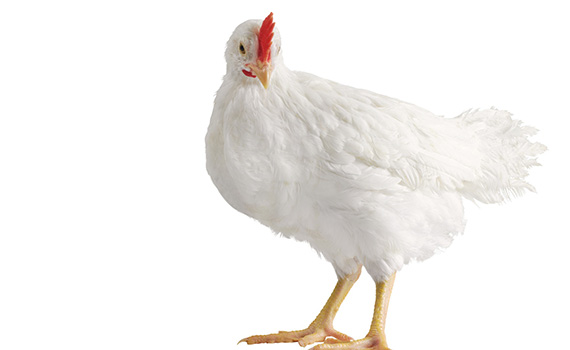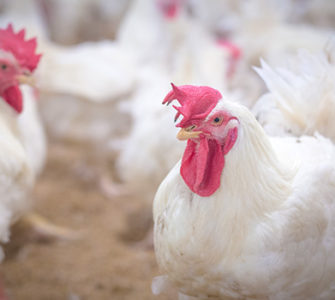Lameness in broilers: Osteomyelitis
By Stephen Collett, BScAgric, BVSc, MMedVet, MRCVS, DACPV
Poultry Diagnostic and Research Center, College of Veterinary Medicine, University of Georgia
Lameness and spinal abscess as a result of bacterial osteomyelitis in broilers is purportedly increasing in prevalence globally. Perhaps the most surprising thing about this is that people are surprised; the two key ingredients for osteomyelitis are bacteraemia and rapid growth. Anyone interested in expanding their knowledge on this condition would do well to read an excellent review by Wideman and Prisby recently published in Frontiers in Endocrinology. Quoting from the abstract “This review provides a comprehensive overview of the vascularization of the avian growth plate and its subsequent role in the pathogenesis of bacterial chondronecrosis with osteomyelitis.“
Osteomyelitis in broilers is very similar to acute osteomyelitis in children and the chicken has consequently served as a suitable model to study the pathonenesis of this condition in humans. These detailed studies have made it quite clear that osteomyelitis in broilers occurs when bacteria that have gained access to the systemic circulation set up a focus of infection in actively growing bones. Since it is the presence of a growth plate at each end of the bone that differentiates a child from an adult it is not surprising that this is the initial site of infection (Fig 1). There are several predisposing factors common to modern broiler production that enable bacteria to firstly gain access to the blood circulatory system and secondly settle and infect actively growing bones.
The innate and acquired immune system of the broiler act in concert to prevent potentially harmful microorganisms from gaining access to the body (forbidden compartment). The resilience of modern broilers to disease bears testimony to the efficiency of this coordinated defense system. However, since microorganisms and bacteria in particular colonize the surface/lining of the respiratory and intestinal tract and skin, it is not surprising that they fromtime to time gain access to the forbidden compartment. A portal of entry for these bacteria is provided by continuous low grade damage to the protective lining (epithelium) of these organ systems. Vaccine virus replication in the respiratory epithelium (Infectious Bronchitis and Newcastle Disease), coccidiosis in the enteric tract and skin scratches are all good examples of ongoing damage and compromised innate immunity. Bacteria that do gain access to the forbidden compartment are rapidly spread by the circulatory system (bacteraemia), and unless eliminated by the immune system, pose a threat to wellbeing. There are several characteristic unique to the growth plate of rapidly growing bones that make it very difficult for the immune system to prevent infection and osteomyelitis.
The blood supply to the growth plate is both from the epiphyseal and diaphyseal sides (Fig 2). As the bone grows in length, the epiphyseal capillaries regress while those from the diaphysis advance. Rapid weight gain creates compression of the capillary bed in the wide growth plate and it is not unusual for areas of ischaemia and even cell necrosis to occur. New capillary growth in this area is by “sprout” formation. Unfortunately during this capillary bed expansion process the tight-junctions between endothelial cells are compromised thus allowing blood and in some cases bacteria to leave the circulation. The outcome of such bacterial contamination of the growth plate depends on the immune system and bacteria interaction. Certain types of bacteria (e.g. Staphylococcus aureus) have the ability to bind to the cartilaginous matrix within the growth plate thus increasing their ability to colonize and infect the site while ischaemia and necrosis enhances the pathogenicity of any bacterial contaminants.
Bone growth in length occurs very rapidly in broilers. The tibia and femur have a close to 4 fold increase in length over a 6 week grow-out (Fig 3. Elongation is the result of cartilaginous cellproliferation at the epiphysis/growth plate surface while calcification and bone formation occurs when the newly generated cartilaginous cells enlarge and degenerate. Since the process of calcification and bone formation is a relatively slow process, growth plate width increases with growth rate. The wide growth plate common to the modern broiler is a point of weakness. Rapid weight gain causes excessive torque and shear forces at the articular surface of the femur, tibia and the free thoracic vertebra in particular (Fig 4). These forces induce micro fractures and cleft formation in the immature cartilaginous growth plate (osteochondrosis) of these bones. This predisposes to infection because damaged growth plate blood vessels release circulating bacteria into the surrounding tissue and the disturbed blood supply causes ischaemia and thrombosis. Once in the clefts or microthrombi, these bacteria are inaccessible to the circulating immune cells and infection and replication is able to continue unabated. Certain strains of bacteria have the ability to bind tightly to the cartilage matrix in the growth plate and are consequently much more likely to cause osteomyelitis.

Figure 4. Cleft formation as a result of tortional/shear forces and microfracture at the growth plate interface
Bacterial infection/colonization is either rapidly followed by physiological and structural changes or, sequestration and quiescence of the bacteria to form micro-abscesses. In the case of the former, release of lytic substances by the bacteria, and inflammatory mediates by immune cells, forms a growing fibrinonecrotic abscess. This enlargement causes further vascular degeneration, ischaemic necrosis, destruction of trabeculae struts and radial growth of the infected site. Micro-abscesses may in contrast remain subclinical or at some later stage develop into an active site of infection.
Osteomyelitis is a very painful condition and affected birds spend more time recumbent. Both the lack of movement and the pressure created by the entire body weight being carried on soft cartilaginous growth plate of the flexed joints, retards blood flow to the affected area. This increases the risk of ischemic necrosis, thrombosis and spread of bacterial infection.
If the proliferating zone remains intact the bone continues to grow in length and the focus of infection/abscess is left behind giving the impression that it is migrating away from the growth plate. If the proliferating zone is damaged the infection may spread to the epiphysis and joint cavity thus precipitating a septic osteoarthritis and possibly even a tenosynovitis.
As growth rates increase the probability of micofracture and infection will likely escalate. Prevention must consequently be directed at eliminating pathogenic strains of bacteria from the normal flora and limiting damage to the epithelial lining.
Article from The Poultry Informed Professional, Issue 128 March/April 2013.
Published by the Department of Population Health, University of Georgia
Editor: Dr Stephen Collett, Associate Professor
Posted on January 1, 2014




















